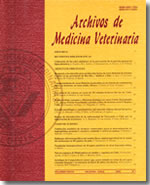Microscopic lesions in salmonids' livers coming from farm fish in the tenth to twelfth Region of Chile (1988-1998)
Main Article Content
Abstract
The purpose of this report is to determine the kinds of microscopic lesions present in livers of salmonids grown in fish farms in the Tenth to Twelfth Region, from 1988 until 1998. Selected histological samples corresponding to 160 coho salmons (O. kisutch), 92 Atlantic salmons (S. salar), 13 chinook salmons (O. tschawytscha) and 90 rainbow trouts (O. mykiss were observed in order to determine the localization of injuries in the liver parenchyma in the Animal Pathology Institute of the Veterinary Science Faculty. The kinds of pathologies found were classified in relation to their localisation in liver tissue according to the theory of Rappaport (1973) about the microcirculatory hepatic unit.
The results of this research indicate that from the total amount of liver samples, the parenchyma localisation of the lesions, when connected to liver disorders (of growth, circulatory, infectious, degenerative, inflammatory and necrotic) were diffuse, accompanied in some cases with a second localisation (periportal, midzone or periacinar). In the case of lymphoblastic infiltration (LL events) and chronic inflammation processes, cells were localised periportally.

